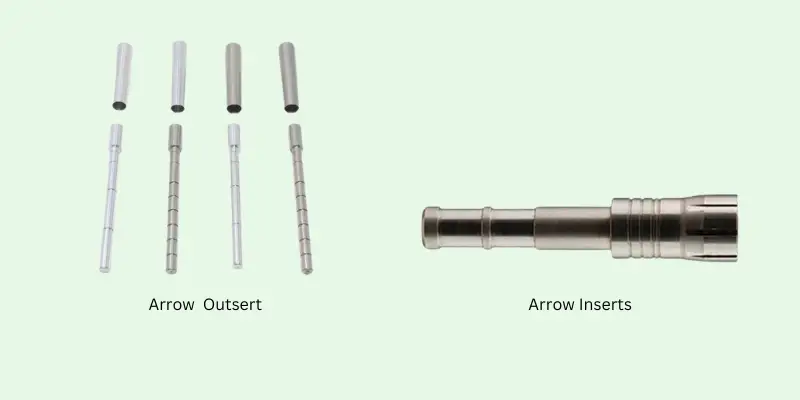Whether it is an arrow insert or outsert, using them is not a mandatory thing. However, you will see clear differences while shooting with them or hitting targets during their absence.
Confused about them? Worry not, we are just about to expand the details.
So, what are the key differences between arrow outsert vs insert? The main difference between them is the area they attach to the arrow shaft. Arrow inserts help archers get the arrow points to the shaft perfectly. On the other hand, arrow outserts permit them to smash up with a standard or giant-sized hole on the shaft.
Though each of them is directly related to the arrow shaft, they affect different areas. Stick with us to get all the spilled beans by the end of this article! Shall we start?
Table of Contents
- Arrow Outsert vs Insert: Detailed Comparison
- Can I Change Arrow Outserts?
- Can I Change Arrow Inserts?
- Is Using Insert And Outsert Combination Good?
Arrow Outsert vs Insert: Detailed Comparison
Both arrow outsert and arrow insert are arrow components. Failure to install them causes issues. Also, in order to remove them from the arrow shaft, you may struggle. Some people also feel afraid of replacing them.
At the same time, it’s a common query if the installation process is the same for both tools or not. We want to break down the misconception and bring out the differences.
Can I Change Arrow Outserts?
Yes, why not! We know many users including you often get afraid of changing outserts and inserts- both.
Worry not, let’s walk along with our stepwise process to change your arrow outserts.
Step 1
First of all, choose the right outsert utilized in your arrow shaft. You might pick outserts made of Aluminum. This specific build construction helps in reinforcing robustness and overall performance.
Step 2
Slide the outsert over the arrow shaft. And then, have a spin test. Not necessarily to run! However, we suggest doing that. This approach is known as dry fitting among archers.
Step 3
Haven’t found the outsert moving to the shaft yet? Worry not. Find 100-grit sandpaper and rub this to your shaft lightly. Don’t get rough on it, you might lose too much of the arrow.
Keep a circular pace so that the whole area gets the treatment equally. Carry this approach on unless you have found the outsert fitting nicely on the shaft.
Step 4
Clean your shaft and wipe out every possible dust if there is any.
Step 5
You can have the spin test again to assure concentricity. Keep the outserts turning until you find spinning nicely.
Step 6
Utilize a sharpie to mark the outset along with your shaft. It gets you a clear idea of better alignments after applying glue there. Remember, gluing in evenly syncs the outsert and shaft better.
Step 7
Finally, let them dry for a while. Once it gets a hard-rock bond, your outsert modification is done.
Hopefully, now you can have the execution more precise and effective.
Can I Change Arrow Inserts?
Leveling the arrow ends horizontally needs to be ensured in the first place to change the inserts.
To change the arrow inserts you need to remove the old inserts. Read this article on how to remove arrow inserts and this article for installing arrow inserts.
But that’s not all. Let’s explore the whole process.
Step 1
Cut the arrow to the desired length. Make sure to keep arrows flat and leveled. Use arrow squaring tools if required. They remove leftover materials having precision in cuts.
Step 2
The lack of insert leveling ends up having a wobbling angle at your arrow. It directly affects the alignment of inserts, shafts, and also accuracy.
Step 3
Place the arrow end at a perfect 90-degree angle while putting shafts on the table. Using HIT inserts? Make sure to place your broadhead against the shaft vertically.
Step 4
Once cuts are done, apply glue to the shaft’s top and insert the bottom side. Afterward, focus on wiping excessive glue and epoxy. Then, wait for a while.
Step 5
Remember, while utilizing the epoxy on the inserts, setting your arrow on a flat surface is better.
Finally, that’s how you get the inserts placed in the right place.
Is Using Insert And Outsert Combination Good?
Definitely yes! Using them combinedly helps your arrow have a robust build structure. More additional materials sticking out in the arrow allow users to push the arrow inserts more in-depth into the arrow shaft.
Interestingly, arrow insert and outsert can balance each other very nicely. So, you might find a better and more integrated performance while having them together. You might know outsiders carrying no internal footers while an insert has this feature.
They can push deeper down the arrow shaft which is absent if you use one of them at a time. Also, they prevent blowing the sidewall.
Another benefit is- users can literally expand two inserts and curve the end with the half out. While moving to the outsert system, you will find an inner and outer footer- both.
They are highly likely to reinforce your arrow shaft from both- inside and outside. And finally, you can protect the sleeves through them.
FAQs
What are the half-out arrow inserts?
Half-out arrow inserts usually provide carbon shafts a better and expanded arrow weight, arrow length, and even strength.
These arrows can be an excellent choice for professional hunters and archers. They also allow better penetration by making your front of center (FOC) increased.
Do I need to glue my arrow nocks in?
No! Gluing isn’t needed with your press-fit nocks. Simply, stick them in while needing them. If not, just pull them out. They are thoroughly indexable. As a result, you can direct them to any position.
Relevantly, they will align better concerning the fletchings. And finally, you will get cable clearance.
Do all arrow tips suit every arrow?
No, one size might not suit every arrow available in the market. Arrows that are poorly constructed and with improper sizing might be flying unsystematically.
Chances are there to find them degrading your overall accuracy too. Finally, they put a safety thread on you and your bows.
What glue should I use for arrow inserts?
Bohning Insert Iron Glue can be great for your arrow inserts. It comes with a rubber-toughened nature that bonds so quickly.
However, Insert Weld Arrow Insert Glue is the best in my opinion. The shock-resistant formula of an Insert Weld contains a 0.008″ Gap Filler. As a result, filling any of your inserts to the arrow shaft gaps properly becomes possible.

